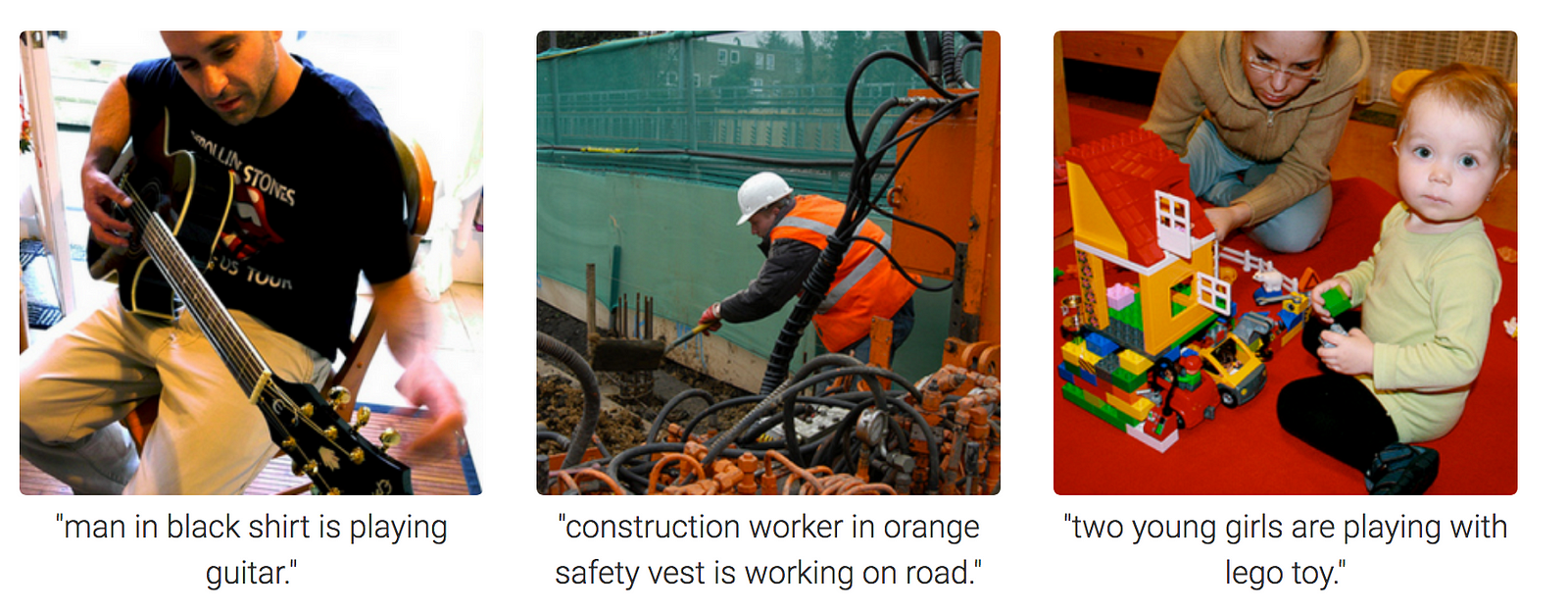dabasajay / Image Caption Generator
Programming Languages
Labels
Projects that are alternatives of or similar to Image Caption Generator
Image Caption Generator
A neural network to generate captions for an image using CNN and RNN with BEAM Search.
Examples
Image Credits : Towardsdatascience
Table of Contents
- Requirements
- Training parameters and results
- Generated Captions on Test Images
- Procedure to Train Model
- Procedure to Test on new images
- Configurations (config.py)
- Frequently encountered problems
- TODO
- References
1. Requirements
Recommended System Requirements to train model.
- A good CPU and a GPU with atleast 8GB memory
- Atleast 8GB of RAM
- Active internet connection so that keras can download inceptionv3/vgg16 model weights
Required libraries for Python along with their version numbers used while making & testing of this project
- Python - 3.6.7
- Numpy - 1.16.4
- Tensorflow - 1.13.1
- Keras - 2.2.4
- nltk - 3.2.5
- PIL - 4.3.0
- Matplotlib - 3.0.3
- tqdm - 4.28.1
Flickr8k Dataset: Dataset Request Form
UPDATE (April/2019): The official site seems to have been taken down (although the form still works). Here are some direct download links:
- Flickr8k_Dataset
- Flickr8k_text Download Link Credits: Jason Brownlee
Important: After downloading the dataset, put the reqired files in train_val_data folder
2. Training parameters and results
NOTE
-
batch_size=64took ~14GB GPU memory in case of InceptionV3 + AlternativeRNN and VGG16 + AlternativeRNN -
batch_size=64took ~8GB GPU memory in case of InceptionV3 + RNN and VGG16 + RNN - If you're low on memory, use google colab or reduce batch size
- In case of BEAM Search,
lossandval_lossare same as in case of argmax since the model is same
| Model & Config | Argmax | BEAM Search |
|---|---|---|
InceptionV3 + AlternativeRNN
|
(Lower the better) (Higher the better) |
BLEU Scores on Validation data (Higher the better) |
InceptionV3 + RNN
|
(Lower the better) (Higher the better) |
BLEU Scores on Validation data (Higher the better) |
VGG16 + AlternativeRNN
|
(Lower the better) (Higher the better) |
BLEU Scores on Validation data (Higher the better) |
VGG16 + RNN
|
(Lower the better) (Higher the better) |
BLEU Scores on Validation data (Higher the better) |
3. Generated Captions on Test Images
Model used - InceptionV3 + AlternativeRNN
4. Procedure to Train Model
- Clone the repository to preserve directory structure.
git clone https://github.com/dabasajay/Image-Caption-Generator.git - Put the required dataset files in
train_val_datafolder (files mentioned in readme there). - Review
config.pyfor paths and other configurations (explained below). - Run
train_val.py.
5. Procedure to Test on new images
- Clone the repository to preserve directory structure.
git clone https://github.com/dabasajay/Image-Caption-Generator.git - Train the model to generate required files in
model_datafolder (steps given above). - Put the test images in
test_datafolder. - Review
config.pyfor paths and other configurations (explained below). - Run
test.py.
6. Configurations (config.py)
config
-
images_path:- Folder path containing flickr dataset images -
train_data_path:- .txt file path containing images ids for training -
val_data_path:- .txt file path containing imgage ids for validation -
captions_path:- .txt file path containing captions -
tokenizer_path:- path for saving tokenizer -
model_data_path:- path for saving files related to model -
model_load_path:- path for loading trained model -
num_of_epochs:- Number of epochs -
max_length:- Maximum length of captions. This is set manually after training of model and required for test.py -
batch_size:- Batch size for training (larger will consume more GPU & CPU memory) -
beam_search_k:- BEAM search parameter which tells the algorithm how many words to consider at a time. -
test_data_path:- Folder path containing images for testing/inference -
model_type:- CNN Model type to use -> inceptionv3 or vgg16 -
random_seed:- Random seed for reproducibility of results
rnnConfig
-
embedding_size:- Embedding size used in Decoder(RNN) Model -
LSTM_units:- Number of LSTM units in Decoder(RNN) Model -
dense_units:- Number of Dense units in Decoder(RNN) Model -
dropout:- Dropout probability used in Dropout layer in Decoder(RNN) Model
7. Frequently encountered problems
-
Out of memory issue:
- Try reducing
batch_size
- Try reducing
-
Results differ everytime I run script:
- Due to stochastic nature of these algoritms, results may differ slightly everytime. Even though I did set random seed to make results reproducible, results may differ slightly.
-
Results aren't very great using beam search compared to argmax:
- Try higher
kin BEAM search usingbeam_search_kparameter in config. Note that higherkwill improve results but it'll also increase inference time significantly.
- Try higher
8. TODO
-
[X] Support for VGG16 Model. Uses InceptionV3 Model by default.
-
[X] Implement 2 architectures of RNN Model.
-
[X] Support for batch processing in data generator with shuffling.
-
[X] Implement BEAM Search.
-
[X] Calculate BLEU Scores using BEAM Search.
-
[ ] Implement Attention and change model architecture.
-
[ ] Support for pre-trained word vectors like word2vec, GloVe etc.
9. References
- Show and Tell: A Neural Image Caption Generator - Oriol Vinyals, Alexander Toshev, Samy Bengio, Dumitru Erhan
- Where to put the Image in an Image Caption Generator - Marc Tanti, Albert Gatt, Kenneth P. Camilleri
- How to Develop a Deep Learning Photo Caption Generator from Scratch







